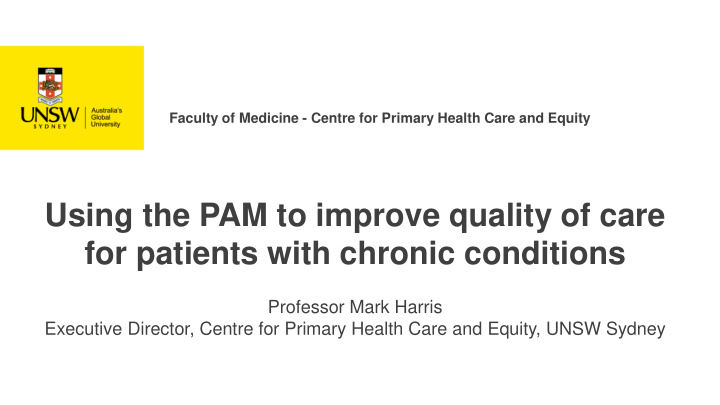



Faculty of Medicine - Centre for Primary Health Care and Equity Using the PAM to improve quality of care for patients with chronic conditions Professor Mark Harris Executive Director, Centre for Primary Health Care and Equity, UNSW Sydney
Using the PAM in SESLHD SESLHD Integrated Care Strategy • Priority 1: Engage with people and communities through person centred planning and evaluation. • Strategy 2: Test use of patient activation, outcome, experience measures and sharing of outcomes across all providers as a tool to improve quality of care.
Rationale for further research • PAM has primarily been used as an outcome measure • Minimal evidence about the use of PAM as a tool to tailor care • Testing the feasibility of implementing the PAM as a tailoring tool
The PAM study Purpose A feasibility study on the use of the PAM to improve quality of care. Three phase project 1. Scoping literature review on use of PAM to improve quality of care. 2. Retrospective record audit investigating use of the PAM in SESLHD. 3. Pilot study to test use of the PAM as a tool to improve the quality of care for patients with chronic conditions.
Phase 1: Scoping literature review Review questions 1. How are PAM results used for adults with chronic conditions? 2. What are the enablers and barriers to the implementation of PAM into clinical practice? 3. What is the impact of PAM assessment on quality of care?
Results: How was PAM used? 1 . As a tool for tailoring care • Care planning and self management: goal setting, coaching, motivational interviewing • Supporting transition from hospital to home • Hospital readmission prevention programs 2. Risk profile assessment for population groups • Clinical indicators plus PAM scores • Stratification to tailored interventions
Results: Enablers & barriers to implementation Organisational level • Structures and systems to support implementation • Cultural changes - patient centred care and self management Clinician level • Perceptions of PAM and its value • Confidence to understand and implement and tailor support • Feasibility within workplace demands, clinical practices/routines Patient level • Ease of understanding the PAM survey questions • Perceptions/acceptance of self-management
Results: Impact on quality of care Clinician behaviour • Communication and feedback techniques • Tailored goal-setting with patients • Referral navigation Patient behaviour • Self management/health behaviours • Use of health services • Improvements in clinical indicators
Phase 2: Retrospective record audit • Patients attending a pulmonary rehabilitation program Research questions 1.What are the PAM scores of patients participating in rehabilitation programs? 2.Do PAM scores change following participation? 3.Is there a relationship between patient demographics, health status and program outcomes and PAM scores?
Results: Retrospective record audit • 61% (n=118) of 194 patients completed the program • Mean (SD) baseline PAM score was 60.5 (15.7) • PAM score improved to 65.4 (15.5) at program completion • Anxiety, lung information needs and health-related quality of life were associated with patient activation
Phase 3: SESLHD PAM pilot Study Study aim To develop and test the use of the PAM tool as part of clinical and team/service practice to improve the quality of care for patients with chronic conditions in SESLHD.
Research questions 1. How well have teams been able to administer the PAM? 2. In what ways has PAM been used to tailor care for individual patients? 3. In what ways has PAM been used to improve the quality of care? 4. Does the process of measuring PAM and using the results influence clinician practice? 5. Is there a change in patient self-management behaviour following the use of the PAM score to tailor care?
Study design • Qualitative case studies • Quality improvement/breakthrough collaborative methodology • Inclusion criteria for clinical programs: o adults with chronic conditions o outpatient setting o rehabilitation and self-management focus
PAM intervention Clinician teams Patients • Participate in training: • Recruited by clinicians - PAM tool • Complete PAM survey - breakthrough collaborative • Results discussed and used to methodology inform patient care plan - motivational interviewing • Complete follow-up PAM survey • Plan ways to implement the PAM as part of routine care • Administer the survey • Results discussed with patients and used to inform care plan
Data collection Method Baseline Intervention Follow-up: period 3-4 mths Patient survey: Patient demographics, health X X information, PAM, Partners in Health scale Team interviews X Clinician survey: CS-PAM tool X Audiotapes of patient-clinician consultations X Patient interviews X Monthly team reports X X X
Project development & implementation • Three teams recruited: 16 clinicians • Clinician training completed: Oct 2016 • Monthly meetings of the PAM implementation group • Patient recruitment commenced July 2017: 51 patients • Team interviews completed • Audio recordings of patient-clinician consultations have commenced
Project reflections • Implementing the PAM as a tailoring tool is a work in progress • Some challenges: - Language & literacy barriers - Unwell patients - Integrating the PAM into established programs • Inform future use of PAM in SESLHD and beyond
Recommend
More recommend